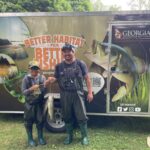Volunteers hunt for invasive beetles across SoCal during the first “GSOB Blitz”
The invasive goldspotted oak borer first struck San Diego County woodlands over a decade ago, and the damage over successive years left “boneyards” behind. That’s how Jan Gonzales describes the dead trees removed after suffering an infestation of the tiny beetles — just piles of chopped wood and bare stumps remaining.
“There were swaths of dead oaks,” Gonzales said. “You could go to a park, and all these trees were having to be cut down. My family lost our favorite camping spot.”
Gonzales has combated these bugs, known as GSOB, throughout her career in community education with the University of California Cooperative Extension Office in San Diego. Since the early 2000s, she’s observed the beetle’s populations spread throughout Southern California, likely hitching a ride on firewood.
This June, UC Agriculture and Natural Resources launched a community science effort to track down new populations of this destructive pest and digitally log the data. The first “GSOB Blitz” recruited volunteers to scour trees for signs of beetles across Los Angeles, San Bernardino, Riverside, Orange and San Diego counties.
“A couple of our groups filled to over capacity overnight. I couldn’t keep up with it fast enough,” Gonzales said. “People were raring to go.”
In total, nearly 200 people attended this pilot blitz, including university students, tree care professionals, environmental consultants, retirees, and hobbyist bug-hunters.
The multi-county event was made possible through funding from CALFIRE and was hosted in partnership with a dozen public and private partners.
Making an example of the beetles
Leaders of the San Diego County blitz brought several examples of GSOB-damaged wood for volunteers to check out, in case they didn’t encounter the real thing.
At the start of the event, Beatriz Nobua-Behrmann, UC Cooperative Extension urban forestry and natural resources advisor, trained the group on identifying the telltale “D-shaped” exit holes left by beetles burrowing out of the bark.
“You have to get up close and personal with the tree,” Nobua-Behrmann said. She demonstrated her searching technique on a random oak, using a flashlight to scan up and down the trunk.
“So I got close to the bark and I looked at the tree and I saw holes. It turns out that was a heavily infested tree, just by chance,” Nobua-Behrmann recalled.
Volunteers ran over to see for themselves. They counted over 50 tiny holes, the right size and shape, dotting the trunk – confirmed evidence of GSOB.
Over the next few hours, community surveyors logged dozens of trees damaged by GSOB into a smartphone app, including details like trunk circumference and oak species. The digital survey was developed by Kim Corella, a forest pathologist with CALFIRE, who will use data collected to establish the latest range maps of the species.
“We ended up finding lots of infested trees, which is unfortunate for the trees, but great for this training,” Nobua-Behrmann said.
People left the event with plans to study oaks in their own yards with a keener eye. Other attendees were professional arborists, excited to train their colleagues on the signs of a GSOB infestation and share tips for safely disposing of damaged wood. All the volunteers are now oak stewards of sorts, charged with sharing the message that transporting firewood is a big no-no – a major risk for spreading the pest.
The data collected will help land managers direct their efforts toward treating trees known to be infested. UC ANR and partners like CALFIRE are available to provide guidance on controlling beetle populations.
According to Nobua-Behrmann, the San Diego County park has been managed for GSOB in the past, but findings from the volunteers warrant follow-up attention at the survey site.
“These are areas where people go and connect with nature. If you lose those trees, then you lose that opportunity to have people fall in love with oaks,” Nobua-Behrmann said.
She’s grateful to have the help of community scientists because there isn’t enough capacity for experts to do this work on their own. She says the response from the public has been overwhelming, with volunteers directly messaging her to offer their time, even after registration reached capacity.
“Now it’s very clear that this blitz is something that works,” Nobua-Behrmann said. “We got so many new collaborators saying, ‘Count us in for the next one.’”
Searching for the love of bugs
Blitz volunteer Ismael Cervantes traveled three hours by bus from Gardena to attend the L.A. County GSOB blitz held in San Dimas. To him, the appeal was simple.
“I love bugs,” Cervantes said. Besides the beetles, he looked forward to getting in some cardio. After two hours of hiking around the San Gabriel Mountains, something caught his eye.
“We saw one tree that looked a little sketchy,” Cervantes said. The oak had a few holes that seemed D-shaped, but no weeping sap, a characteristic of GSOB damage.
Los Angeles County is currently infested with some of the northernmost populations of GSOB in California, according to range maps distributed by UC ANR. The extent of the beetle’s spread in the area is still largely unknown.
Nathaniel Carbajal, another volunteer, admitted conflicted feelings about the possibility of encountering GSOB in the region.
“ I’m hopeful we won’t, but there’s a part of me that kind of wants to find them because I want to check them out and learn what I can,” Carbajal said. He’s starting a career in urban forestry and has previously surveyed for shot-hole borers, another invasive pest.
“I fell in love with looking for insects,” Carbajal said. Since his graduate program didn’t offer entomology courses, Carbajal had to find other pathways to study beetles.
“This is my opportunity to fulfill something that I’ve been wanting to do since I was a child,” Carbajal said. “These citizen science activities are very accessible.”
In the end, no GSOB was confirmed at the Los Angeles event. When reviewed by an expert entomologist, those sketchy holes didn’t make the cut.
Even so, Cervantes and Carbajal weren’t deterred. Both said they will keep looking for the beetles, even now that the blitz has ended. Based on the success of this pilot, the event leaders are already planning follow-up outings to meet the demand.
Partners on the GSOB Blitz include the San Diego County Department of Parks & Recreation, Resource Conservation District of Greater San Diego County, TEAM Resource Conservation District, UC Riverside, Irvine Ranch Conservancy, Mountain Communities Fire Safe Council, Inland Empire Resource Conservation District, Los Angeles County Department of Agricultural Commissioner/Weights & Measures, Los Angeles County Department of Parks and Recreation, and Los Angeles County Fire Department.




GIPHY App Key not set. Please check settings